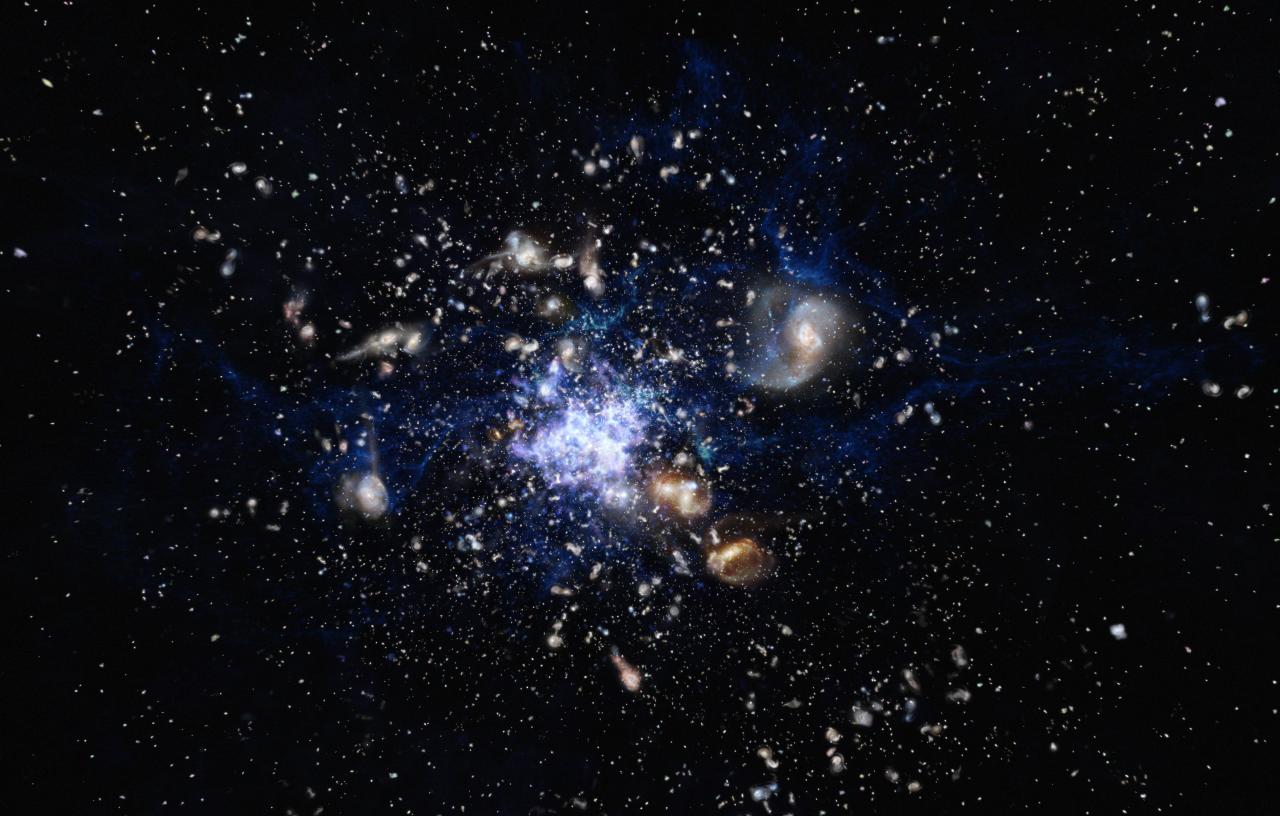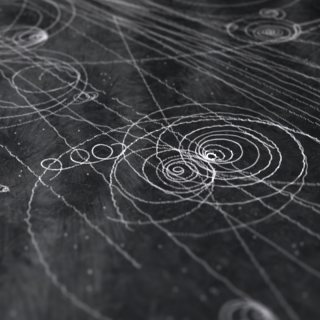Grants related:
General
Two of the most fundamental questions in astrophysics are the conversion of molecular gas into stars and how this physical process is a function of environments on all scales, ranging from planetary systems, stellar clusters, galaxies to galaxy clusters. The main goal of this internal project is to get insight into the formation and evolution of galaxies from the cold interstellar medium. This is achieved by probing the cold molecular gas, the fuel of star formation, and dust, the by-product of this formation process, in galaxies across cosmic time. The studies are mainly based on observations in the far-infrared and radio wavelength regime with a special focus on radio interferometric observations with state-of-the art telescopes such as NOEMA, ALMA, ATCA, VLA and SMA. There will be close interrelation with other internal research projects e.g., providing our expertise on radio (interferometric) observations of galaxies. The research group will characterize the star-formation properties of massive galaxies in the distant universe at different epochs enabling us to study the formation sequence of star-forming galaxies. Furthermore, to probe the environmental-dependent evolution, the investigated sources are selected from galaxy clusters and the field. In addition, complementary studies of nearby galaxies (selected from CALIFA and WEAVE-APERTIF) serve as a local reference sample for future studies of high-redshift galaxies.
Members
Results
- Follow-up observations of a lensed dusty starburst galaxy at z=2.04 with the radio interferometer IRAM NOEMA discovered extreme molecular gas properties and revealed the brightest emission in molecular gas ever seen in the distant universe; Dannerbauer et al. 2019, AJ, in press (astro-ph/1812.03845)..
- Contrubution with several articles as co-author (part of international collaborations) of the study of galaxy cluster in formation and its members via multi-wavelenth observations.
- Obtaining external funding from 'plan nacional' by MINECO for 2018 and 2019 including funding of a two-years postdoc (AYA2017-84061-P: ´From the first over-densitities to proto-clusters and clusters: The role of the environment´, 141.570 Euro, IP1: H. Dannerbauer, IP2: J. M. Rodriguez-Espinosa).
- Obtaining observing time to continue and the finish the ATCA Large Program 'COALAS: CO ATCA Legacy Archive of Star-Forming Galaxies' (PI: Helmut Dannerbauer), in total 640 hrs. (~500.000 Euro). IRAM NOEMA Large Program ‘A Comprehensive NOEMA Redshift Survey of the Brightest Herschel Galaxies’ (CoPI: Dannerbauer) approved, 191 hrs. (~770.000 Euro).
- Organization of the mini-synposium 'Build-Up of Galaxy Clusters' during the IAU XXX General Assembly in Vienna in August 2018 and of the splinter meeting "Collaborative GTC-LMT project" during the GTC conference in Valencia in December 2018.
Scientific activity
Related publications
-
The Typical Massive Quiescent Galaxy at z ∼ 3 is a Post-starburst
We have obtained spectroscopic confirmation with Hubble Space Telescope WFC3/G141 of a first sizeable sample of nine quiescent galaxies at 2.4 < z < 3.3. Their average near-UV/optical rest-frame spectrum is characterized by low attenuation (A V ∼ 0.6 mag) and a strong Balmer break, larger than the 4000 Å break, corresponding to a fairly young age
D'Eugenio, C. et al.Advertised on:
32020 -
Extended Hα over compact far-infrared continuum in dusty submillimeter galaxies. Insights into dust distributions and star-formation rates at z ∼ 2
By using data from the Atacama Large Millimeter/submillimeter Array and near-infrared (NIR) integral field spectrographs, including both Spectrograph for INtegral Field Observations in the Near Infrared and K-band Multi Object Spectrograph on the Very Large Telescope, we investigate the two-dimensional distributions of Hα and rest-frame far
Chen, Chian-Chou et al.Advertised on:
32020 -
NOEMA redshift measurements of bright Herschel galaxies
Using the IRAM NOrthern Extended Millimeter Array (NOEMA), we conducted a program to measure redshifts for 13 bright galaxies detected in the Herschel Astrophysical Large Area Survey with S 500 μm ≥ 80 mJy. We report reliable spectroscopic redshifts for 12 individual sources, which are derived from scans of the 3 and 2 mm bands, covering up to 31
Neri, R. et al.Advertised on:
32020 -
The Properties of the Interstellar Medium of Galaxies across Time as Traced by the Neutral Atomic Carbon [C i]
We report Atacama Large Millimeter Array observations of the neutral atomic carbon transitions [C i] and multiple CO lines in a sample of ̃30 main-sequence galaxies at $z\sim 1$ , including novel information on [C i] ${(}^{3}{P}_{2}{\mbox{--}}^{3}{P}_{1})$ and CO $(7\mbox{--}6)$ for 7 of such normal objects. We complement our observations with a
Valentino, Francesco et al.Advertised on:
22020 -
SCUBA-2 Ultra Deep Imaging EAO Survey (Studies). III. Multiwavelength Properties, Luminosity Functions, and Preliminary Source Catalog of 450 μm Selected Galaxies
We construct a SCUBA-2 450 μm map in the COSMOS field that covers an area of 300 arcmin 2 and reaches a 1σ noise level of 0.65 mJy in the deepest region. We extract 256 sources detected at 450 μm with signal-to-noise ratios >4.0 and analyze the physical properties of their multiwavelength counterparts. We find that most of the sources are at z ≲ 3
Lim, Chen-Fatt et al.Advertised on:
22020 -
On the Gas Content, Star Formation Efficiency, and Environmental Quenching of Massive Galaxies in Protoclusters at z ≈ 2.0─2.5
We present ALMA Band 6 (ν = 233 GHz, λ = 1.3 mm) continuum observations toward 68 “normal” star-forming galaxies within two Coma-like progenitor structures at z = 2.10 and 2.47, from which ISM masses are derived, providing the largest census of molecular gas mass in overdense environments at these redshifts. Our sample comprises galaxies with a
Zavala, J. A. et al.Advertised on:
122019 -
Merger induced clump formation in distant infrared luminous starburst galaxies
While the formation of stellar clumps in distant galaxies is usually attributed to gravitational violent disk instabilities, we show here that major mergers also represent a competitive mechanism to form bright clumps. Using ̃0.1″ resolution ACS F814W images in the entire COSMOS field, we measured the fraction of clumpy emission in 109 main
Calabrò, Antonello et al.Advertised on:
122019 -
A SCUBA-2 selected Herschel-SPIRE dropout and the nature of this population
Dusty star-forming galaxies (DSFGs) detected at z > 4 provide important examples of the first generations of massive galaxies. However, few examples with spectroscopic confirmation are currently known, with Hershel struggling to detect significant numbers of z > 6 DSFGs. NGP6_D1 is a bright 850 μm source (12.3 ± 2.5 mJy) with no counterparts at
Greenslade, J. et al.Advertised on:
122019 -
Discovery of Four Apparently Cold Dusty Galaxies at z = 3.62─5.85 in the COSMOS Field: Direct Evidence of Cosmic Microwave Background Impact on High-redshift Galaxy Observables
We report Atacama Large Millimeter Array (ALMA) observations of four high-redshift dusty star-forming galaxy candidates selected from far-infrared (FIR)/submillimeter observations in the COSMOS field. We securely detect all galaxies in the continuum and spectroscopically confirm them at z = 3.62─5.85 using ALMA 3 mm line scans, detecting multiple
Jin, S. et al.Advertised on:
122019 -
SCUBA-2 observations of candidate starbursting protoclusters selected by Planck and Herschel-SPIRE
We present SCUBA-2 850 μm observations of 13 candidate starbursting protoclusters selected using Planck and Herschel data. The cumulative number counts of the 850 μm sources in 9 of 13 of these candidate protoclusters show significant overdensities compared to the field, with the probability <10 -2 assuming the sources are randomly distributed in
Cheng, T. et al.Advertised on:
122019 -
The Atacama Large Aperture Submillimeter Telescope (AtLAST)
Overview of the science cases for, and technologies required for a new single dish sub-mm telescope. AtLAST is envisioned as a 50m diameter single dish with a 1deg field of view that will be able to map the large scale structures of the Universe inaccessible to ALMA with mapping speeds 1000s of times faster than current or planned facilities.
Klaassen, Pamela et al.Advertised on:
92019 -
The nature of faint radio galaxies at high redshifts
We present spectra and near-infrared images of a sample of faint radio sources initially selected as promising high-redshift radio galaxy (HzRG) candidates. We have determined redshifts for a total of 13 radio galaxies with redshifts ranging from 0.52 ≤ z ≤ 5.72. Our sample probes radio luminosities that are almost an order of magnitude fainter
Saxena, A. et al.Advertised on:
112019 -
MAGPHYS+photo-z: Constraining the Physical Properties of Galaxies with Unknown Redshifts
We present an enhanced version of the multiwavelength spectral modeling code MAGPHYS that allows the estimation of galaxy photometric redshift and physical properties (e.g., stellar mass, star formation rate, dust attenuation) simultaneously, together with robust characterization of their uncertainties. The self-consistent modeling over ultraviolet
Battisti, A. J. et al.Advertised on:
92019 -
Neutral carbon and highly excited CO in a massive star-forming main sequence galaxy at z = 2.2
We used the Plateau De Bure Interferometer to observe multiple CO and neutral carbon transitions in a z = 2.2 main sequence disk galaxy, BX610. Our observation of CO(7-6), CO(4-3), and both far-infrared (FIR) [CI] lines complements previous observations of Hα and low-J CO, and reveals a galaxy that is vigorously forming stars with UV fields (Log
Brisbin, Drew et al.Advertised on:
82019 -
The Dust and Molecular Gas in the Brightest Cluster Galaxy in MACS 1931.8-2635
We present new Atacama Large Millimeter Array observations of the molecular gas and far-infrared continuum around the brightest cluster galaxy (BCG) in the cool-core cluster MACS 1931.8-2635. Our observations reveal (1.9 ± 0.3) × 1010 M ⊙ of molecular gas, on par with the largest known reservoirs of cold gas in a cluster core. We detect CO(1‑0), CO
Fogarty, Kevin et al.Advertised on:
72019 -
Ultra-bright CO and [{\rm{C}}\,{\rm{I}}] Emission in a Lensed z = 2.04 Submillimeter Galaxy with Extreme Molecular Gas Properties
We report the very bright detection of cold molecular gas with the IRAM NOEMA interferometer of the strongly lensed source WISE J132934.18+224327.3 at z = 2.04, the so-called Cosmic Eyebrow. This source has a similar spectral energy distribution from optical-mid/IR to submillimeter/radio but significantly higher fluxes than the well-known lensed
Dannerbauer, H. et al.Advertised on:
72019 -
The Main Sequence at z ∼ 1.3 Contains a Sizable Fraction of Galaxies with Compact Star Formation Sizes: A New Population of Early Post-starbursts?
Atacama Large Millimeter/submillimeter Array (ALMA) measurements for 93 Herschel-selected galaxies at 1.1 ≤ z ≤ 1.7 in COSMOS reveal a sizable (>29%) population with compact star formation (SF) sizes, lying on average >×3.6 below the optical stellar mass (M ⋆)–size relation of disks. This sample widely spans the star-forming main sequence (MS)
Puglisi, A. et al.Advertised on:
62019 -
ALMA Reveals Potential Evidence for Spiral Arms, Bars, and Rings in High-redshift Submillimeter Galaxies
We present subkiloparsec-scale mapping of the 870 μm ALMA continuum emission in six luminous (L IR ∼ 5 × 1012 L ⊙) submillimeter galaxies (SMGs) from the ALESS survey of the Extended Chandra Deep Field South. Our high-fidelity 0.″07-resolution imaging (∼500 pc) reveals robust evidence for structures with deconvolved sizes of ≲0.5–1 kpc embedded
Hodge, J. A. et al.Advertised on:
52019 -
The new 4-m robotic telescope
We present a project to build a 4-m-diameter telescope (New Robotic Telescope [NRT]) with fully robotic operation. The telescope will be sited at the Observatory of Roque de los Muchachos in the island of La Palma (Spain). When it enters into operation in 5 years' time, it will be likely the largest robotic telescope in the world. This, in
Gutiérrez, C. M. et al.Advertised on:
12019 -
High Gas Fraction in a CO-detected Main-sequence Galaxy at z > 3
We report NOrthern Extended Millimetre Array (NOEMA) observations of warm molecular gas traced by CO(5 ‑ 4) in a z∼ 3.2 gas-rich main-sequence (MS) galaxy, initially serendipitously detected in CO(3 ‑ 2) emission in “blind” deep NOEMA observations. Our target shows a gas excitation consistent with that seen in z∼ 1.5 MS galaxies ({L}CO(5-4)}{\prime
Gowardhan, A. et al.Advertised on:
42019



![Teacup in [O III] and CO(2-1) Supermassive black holes modify the distribution of molecular gas in the central regions of galaxies. Credit: HST and C. Ramos Almeida.](/sites/default/files/styles/crop_square_2_2_to_320px/public/images/project/teacup_english.001.jpeg?itok=dF4bDw-q)